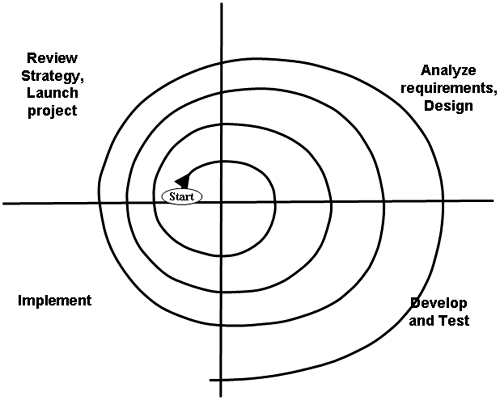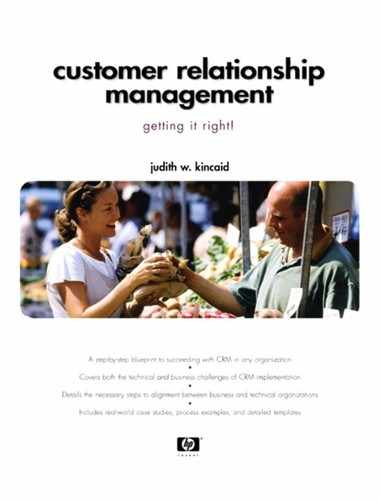5.3. Building a CRM Component
CRM is neither a silver bullet nor a magic wand. It takes careful planning and management to be in a position to successfully.
PHASE 2—BUILD THE INFRASTRUCTURE
Many quick-fix specialists believe that you can just “do CRM”! Just get Information Technology to build a web site personalization capability. Forget that you don't have any customer knowledge to decide what to do for whom. Part 3 of this book is devoted to understanding in detail what it takes to develop the infrastructure that is a required to enable an integrated and successful CRM program. Here, we will just review the method.
5.3.1. Process Steps
The development process steps will be used to manage efforts in each of the components of the infrastructure (process, information, people, and technology). All infrastructure development projects follow the same basic and well-understood method.
Launch
Analysis
Design
Construct/Test
Implement
As we just saw, the project launch is the transition from CRM lifecycle phases 1 when we determined the business need and developed the project plan. The focus of Phase 2 is the analysis, design and construction of all the infrastructure elements required to meet the project objective. Implementation (integration) occurs during the transition to Phase 3. These steps, which describe the “waterfall” method of software development but can be applied to all components, are described in Table 5-2.
| Step | Purpose | Participants |
|---|---|---|
| Gather and analyze requirements | Identify business needs for information, process, technology and people Analyze and compare to existing infrastructure | Project Team Business function experts |
| Design component | Develop a detailed design | Business function experts Information Technology |
| Construct solution | Code and test information and technology solutions | Information Technology |
| Develop process and people change solutions | Business function experts | |
| Transition: Integrate Capability | Information Integration (consistency)
Process Integration (continuity) Technology Integration (compatibility) People Integration (congruity) | Information Technology Business Function |
We use this same waterfall method for each of the small projects we launch, learning from previous results as we start the next project. Barry Boehm, a professor at the University of Southern California's Center for Software Engineering, named this evolutionary development approach the spiral model in his 1986 paper “A Spiral Model of Software Development and Enhancement,” as shown in Figure 5-4.
Figure 5-4. The Spiral Development Model

We will discuss this phase in more detail for each piece of the infrastructure so that we understand exactly what we need to get done.
5.3.2. What You'll Get
Not surprisingly, the major deliverable of this phase is the infrastructure itself, one piece at a time, of course. At the end of Phase 2, we are likely to have new or modified processes, improved customer information, additional technical tools, and the training, education, metrics, and rewards necessary to ensure that the new capabilities are adopted throughout the organization.
As soon as we have delivered the first piece of infrastructure, we also need to be prepared to manage the new capabilities. In particular, customer information is extremely volatile, and it is virtually worthless if the quality deteriorates without check. We will take a very detailed look at what is required to manage customer information quality in Chapter 20.
5.3.3. Transition: Integrate Capability
In the transition to Phase 3, we do the actual work of pulling relevant information together, merging new processes into existing workflows, etc. Unless we actually follow through on our strategy of integration, we will remain in disconnected operational silos that have no impact on our ability to improve the customer experience.
Sadly, because legacy customer data has generally been so poorly managed, this is the area that can take the most work and yet is so often overlooked. You may be thinking, “it's just names and addresses, so how hard can it be?” I am amazed at the number of companies that spend lots of money building a complex and expensive customer analysis capability that it then applies to lousy data. The only result is the companies' ability to make bad decisions more quickly!
It's time to take our efforts outside. We have completed all the necessary internal effort (information, process, technology and people change management) and are ready to give our customers the benefit of all our hard work.
